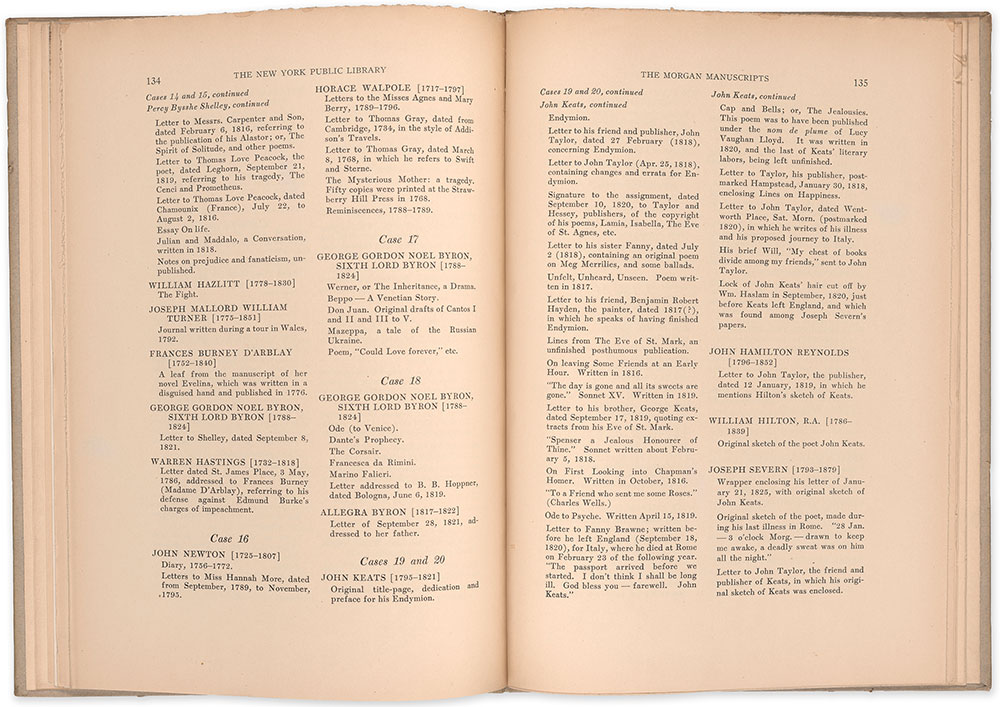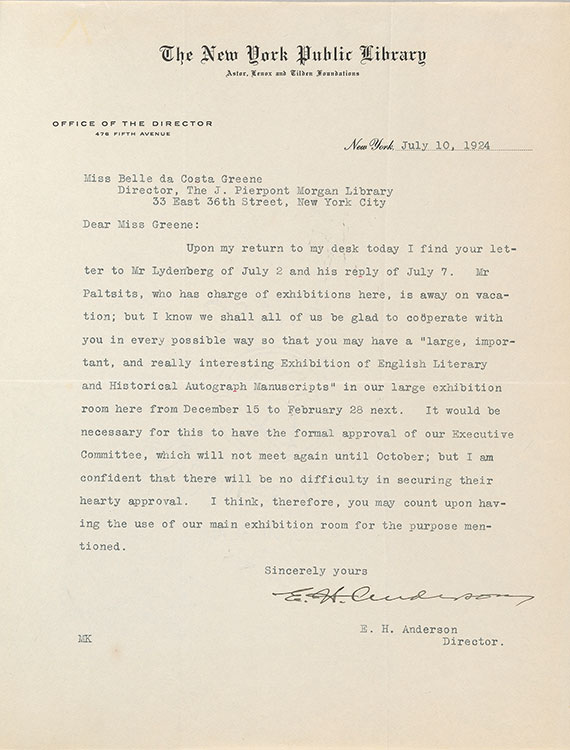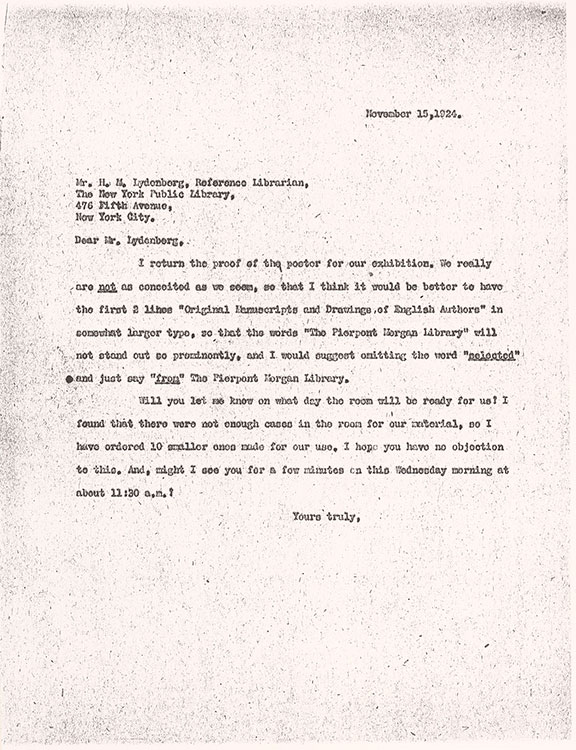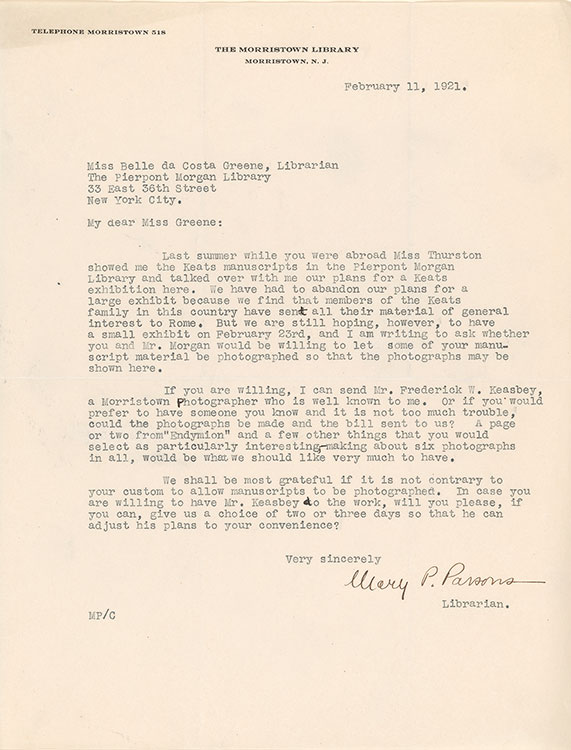Exhibiting Keats

Greene became the Morgan’s first director in 1924, when J. P. Morgan, Jr., established the library as a public institution. Before the Morgan’s gallery space was completed in 1926, Greene and her staff mounted exhibitions at the New York Public Library, for whom Mr. Morgan served as a trustee and Vice President. Following a successful NYPL exhibition of the Morgan’s American historical manuscripts in the spring of 1924, Original Manuscripts and Drawings of English Authors from the Pierpont Morgan Library opened in December 1924 and closed the following April, attracting around 180,000 visitors to see over 300 collection items—at the time the largest exhibition of manuscripts in American history. Belle Greene put on view twenty-seven objects by or related to Keats, one of the best-represented authors on display, and included nearly every Keats artifact from the present exhibition. A catalogue of the exhibition was printed privately but also reprinted in the New York Library Bulletin of March 1925.
Edmund Lester Pearson, “The Morgan Manuscripts,” Bulletin of the New York Public Library, Volume 29, Number 3 (1925). Ref 913 P3. Morgan Library Reference Collection.
E.H. Anderson letter to Belle da Costa Greene, 10 July 1924

The Archives of the Morgan Library & Museum hold correspondence between Greene and colleagues at NYPL that provide additional details about the planning of Original Manuscripts and Drawings of English Authors from the Pierpont Morgan Library. A letter to Greene from Director E.H. Anderson, dated July 10, 1924, responds to her query about mounting a “large, important, and really interesting Exhibition of English Literary and Historical Autograph Manuscripts” in NYPL’s exhibition space. Citing the requisite consent of NYPL’s Executive Committee, Anderson assures Greene “there will be no difficulty in securing their hearty approval.”
E.H. Anderson, typed letter to Belle da Costa Greene, 10 July 1924. ARC 1310. Archives of the Morgan Library & Museum.
Belle da Costa Greene letter to H.M. Lydenberg, 15 November 1924

Greene proceeds to correspond with H.M. Lydenberg, Reference Librarian at NYPL, about various exhibition matters including the checklist, labels, opening and closing dates, and even a promotional poster. In reviewing a proof of the poster, which apparently sported “The Pierpont Morgan Library” in rather large lettering, Greene writes, “We really are not as conceited as we seem, so that I think it would be better to have the first 2 lines of ‘Original Manuscripts and Drawings of English Authors’ in somewhat larger type, so that the words ‘The Pierpont Morgan Library’ will not stand out so prominently.” From institutional negotiations and checklist development to label writing and promotional materials, Belle Greene was deeply involved in every aspect of the Morgan’s first exhibition of literary manuscripts.
Belle da Costa Greene, retained copy of typed letter to H.M. Lydenberg, 15 November 1924. ARC 1310. Archives of the Morgan Library & Museum.
Mary P. Parsons letter to Belle da Costa Greene, 11 February 1921

Three years earlier, in February 1921, the world commemorated the 100th anniversary of Keats’s death. Though there was no display marking this occasion at the Library, Belle Greene entertained numerous requests for loans or photography of the Morgan’s Keats collection for various centenary exhibitions. The Librarian of the Morristown Library, Mary P. Parsons, wrote Greene to request photography of a few holdings from the Morgan for inclusion in a Keats exhibition scheduled for February 23rd. The largest centenary show took place at Harvard, which featured rarely or never-before-displayed manuscripts from the two important private Keats collections in America, owned by Amy Lowell and J.P. Morgan, Jr. Correspondence with Harvard in the Morgan Archives documents the list of objects on loan for this exhibition, including the two Keats letters acquired by Greene early in her career, “Ode to Psyche,” the sonnet on Fanny Brawne titled “The day is gone and all its sweets are gone!”, and Shelley’s letter presenting Adonais to Joseph Severn.
Through her acumen in collection development, her collaborative work with scholars, and her efforts at outreach and exhibition design, Belle Greene played an instrumental role in making the Morgan’s Keats collection one of the best known in the world.
Mary P. Parsons, typed letter to Belle da Costa Greene, 11 February 1921. ARC 1310. Archives of the Morgan Library & Museum .